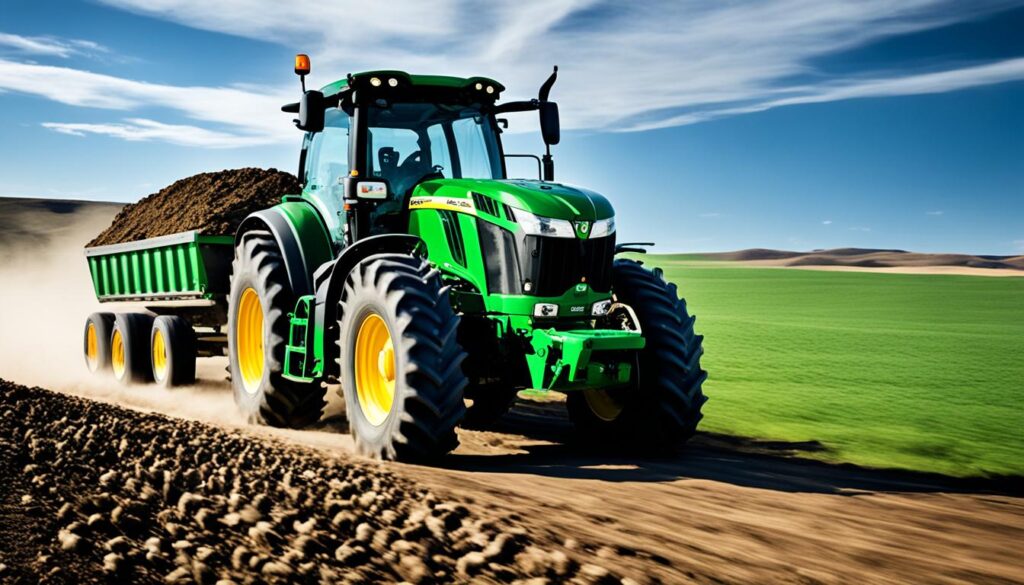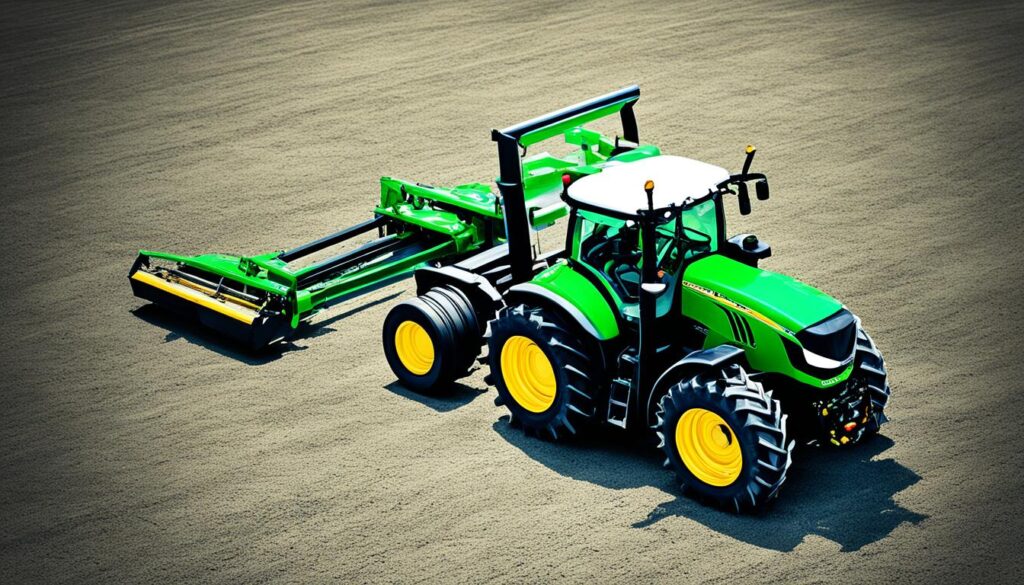Proper tractor weight distribution is crucial for enhancing performance and safety. By understanding the factors that affect weight distribution and following guidelines for ballasting, tire selection, and inflation, we can maximize the efficiency of our tractors and implements. This article explores techniques to optimize a tractor’s balance for peak efficiency, reducing fuel consumption, soil compaction, and wear on drivetrain components.
Key Takeaways
- Proper tractor weight distribution is essential for improving performance, fuel efficiency, and reducing soil compaction and drivetrain wear.
- Understanding the factors that affect weight distribution, such as implement weight, ballast weight, and weight transfer, is crucial for optimizing tractor performance.
- Following guidelines for tire selection, configuration, and inflation can help ensure the tractor’s weight is properly distributed and the tires are working efficiently.
- Adjusting the tractor’s ballast weight and position can improve drawbar load, three-point hitch forces, and overall tractor stability and center of gravity.
- Regularly monitoring and adjusting tractor weight distribution can help maintain peak performance and efficiency throughout the season.
Understanding Tractor Weight Distribution
Proper weight distribution is a critical factor in optimizing tractor performance. The overall weight of the tractor and how that weight is distributed between the axles can have a significant impact on the machine’s efficiency and longevity. Overloading a tractor can waste fuel due to increased rolling resistance and cause premature wear on the drivetrain and soil compaction. Conversely, underloading can lead to excessive tire slip, wasted fuel, and tire wear.
Importance of Proper Weight Distribution
Tractor manufacturers typically recommend optimum weights ranging from 90 to 140 lbs. per PTO horsepower, with the weight distribution varying based on tractor type and implement configuration. Maintaining the right tractor weight distribution and weight ratio is essential for achieving maximum productivity and minimizing operational costs.
Factors Affecting Weight Distribution
- Tractor type (2WD, MFWD, 4WD)
- Implement hitching method (towed, semi-mounted, fully-mounted)
- Addition of suitcase weights to the front of the tractor
When adding suitcase weights to the front, the front axle weight will increase more than the actual weight added, while the rear axle weight will decrease. Tractor manufacturers can provide tables to help calculate these weight transfer effects and ensure proper axle weight distribution.
“Maintaining the right tractor weight distribution and weight ratio is essential for achieving maximum productivity and minimizing operational costs.”
Tractor Weight Distribution Guidelines
Achieving optimal tractor performance requires a strategic approach to weight distribution and tire management. By following these guidelines, you can ensure your tractor is operating at its full potential while minimizing soil compaction and maximizing traction.
First, it’s crucial to determine the appropriate total tractor weight based on the PTO horsepower. As a general rule, aim for 120-145 lbs per PTO hp for MFWD tractors and 95-125 lbs per engine hp for 4WD tractors. This balanced weight ensures efficient power transfer and controlled maneuverability.
Next, distribute the weight wisely, with 35-40% on the front axle and 60-65% on the rear axle for MFWD tractors, or 55-60% on the front and 40-45% on the rear for 4WD tractors. This weight distribution formula helps maintain traction and stability, even in challenging terrain or field conditions.
To achieve the desired weight distribution, utilize a combination of cast weights and liquid ballast. Be mindful of the weight transfer effects, ensuring you don’t overload any single axle or component.
Lastly, inflate your tires to the lowest recommended pressure for the load. This not only maximizes traction but also minimizes soil compaction, preserving the health and productivity of your fields.

“Proper tractor weight distribution is crucial for maximizing performance and protecting the soil.”
By following these tractor weight distribution guidelines, you can unlock the full potential of your tractor, enhancing productivity, efficiency, and sustainability on your farm or worksite.
Tire Selection, Configuration, and Inflation
When it comes to optimizing tractor performance, the selection, configuration, and inflation of tractor tires play a critical role. Choosing the right tires can make a significant difference in traction, flotation, and overall efficiency.
Tire Selection for Performance
For superior performance, we recommend selecting radial tires over bias ply tires. Radial tires provide a larger footprint on the soil, reducing wheel slip and compaction. Additionally, opting for the largest tires that can be accommodated allows for lower inflation pressures between 6-14 psi, which can improve traction and ride quality.
Tire Configuration and Duals
On 2WD and 4WD tractors, duals are often required to enhance flotation, traction, and load-carrying capacity. However, when it comes to MFWD tractors, duals should only be added to the rear axle if necessary for load-carrying purposes. Research has shown that a properly ballasted MFWD tractor with single tires on the rear will perform better than one equipped with duals, as the rear tires can better ride over the firmed soil left by the front tires.
By carefully selecting, configuring, and maintaining the proper inflation of your tractor tires, you can optimize weight distribution and maximize the performance of your equipment, whether you’re operating a 2WD, 4WD, or MFWD tractor.
Conclusion
Optimizing tractor weight distribution is a crucial step in maximizing the performance and efficiency of agricultural equipment. By following the guidelines for total weight, weight distribution, and tire management, we can improve traction, reduce soil compaction, enhance fuel efficiency, and extend the lifespan of our tractor’s drivetrain components. Proper ballasting and tire setup allow the tractor to transfer power to the ground more effectively, leading to improved implement performance and increased productivity in the field.
Achieving the right balance of tractor weight distribution is essential for unlocking the full potential of our agricultural machinery. Through careful consideration of factors like load distribution, tire selection, and inflation pressure, we can optimize our tractor’s performance and create a more sustainable and efficient farming operation. By embracing these best practices, we can ensure our tractors operate at their peak, delivering the power and versatility needed to tackle even the most demanding agricultural tasks.
As we continue to push the boundaries of tractor technology and innovation, the importance of weight distribution will only grow. By staying informed and proactively managing this critical aspect of our equipment, we can stay ahead of the curve, maximize our productivity, and contribute to the long-term sustainability of our farming operations.
FAQ
What is the importance of proper tractor weight distribution?
Proper tractor weight distribution is crucial for enhancing performance and safety. By understanding the factors that affect weight distribution and following guidelines for ballasting, tire selection, and inflation, farmers can maximize the efficiency of their tractors and implements.
How do the type of tractor and implement hitching method affect weight distribution?
The type of tractor (2WD, MFWD, 4WD) and the method of implement hitching (towed, semi-mounted, fully-mounted) can significantly impact the tractor’s weight distribution. The addition of suitcase weights to the front of the tractor also affects the weight transfer between the axles.
What are the guidelines for optimal tractor weight distribution?
To achieve optimal tractor performance, we recommend:
– Determining the appropriate total tractor weight based on the PTO horsepower, aiming for 120-145 lbs per PTO hp for MFWD tractors and 95-125 lbs per engine hp for 4WD tractors.
– Distributing the weight 35-40% on the front axle and 60-65% on the rear axle for MFWD tractors, or 55-60% on the front and 40-45% on the rear for 4WD tractors.
– Using a combination of cast weights and liquid ballast to achieve the desired weight distribution, being mindful of the weight transfer effects.
How does tire selection and inflation pressure affect tractor performance?
Tire selection, configuration, and inflation pressure play a critical role in tractor performance. We recommend selecting radial tires over bias ply tires, as radials provide a larger footprint on the soil, reducing wheel slip and compaction. Choosing the largest tires that can be accommodated and inflating them to the lowest recommended pressure (6-14 psi) can improve traction and ride quality.
When should duals be used on a tractor?
Duals are often required on 2WD and 4WD tractors to improve flotation, traction, and load-carrying capacity. However, duals should not be added to the rear axle of MFWD tractors unless necessary for load-carrying, as a properly ballasted MFWD tractor with single tires on the rear will perform better.


